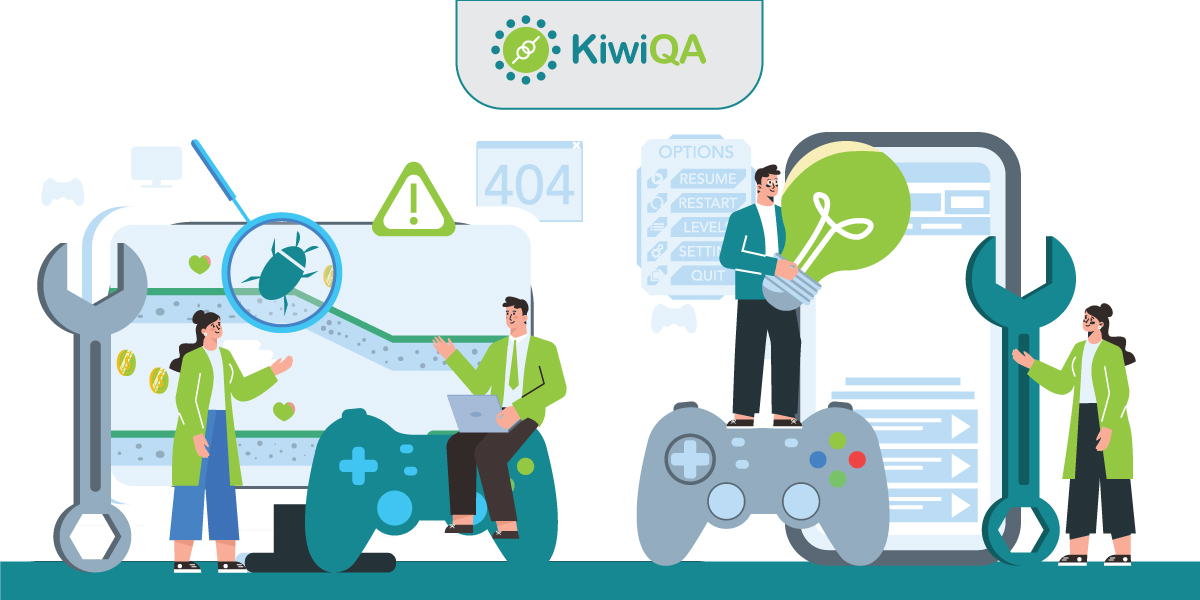Anyone who has played games to entertain themselves undoubtedly has seen how certain games have a tendency to abruptly crash or halt at vital points. This not only makes the user angry and frustrated but also gets the company a bad reputation. In addition to causing you to lose any unsaved data, such bugs will make you strongly want to throw your phone away in anger. The intense discontent experienced at certain times is so profound that it often inspires players to harbor animosity against the game’s creators.
We hope now you understand the importance of game testing. So let’s now dive into the details of game testing and what techniques can help you to reach the top in the market.
But First, What Distinguishes Game Testing From Other Types Of Software Testing?
Every new build (application or software) may include issues, therefore testing games requires repeated testing. No matter what the size of the game is or how long it took to create, all game testing adheres to a fundamental framework.
The quality assurance specialist must learn the game’s criteria and regulations. Know the flow of the game, the file structures, and the dependencies connected to it, as well as the overall component and file architecture. The testing documentation has to be periodically reviewed in order to reflect any changes to the requirements, new test cases for game testing, and new configuration support. A tester for games should make sure that no new problems are created.
A game tester’s duties includes the following:
- To sort the requirements according to the intended use and intended audience.
- To sort the user and system demands into functional, non-functional, and domain requirements.
- To determine the testable and non-testable components as well as the goals and metrics for the functional and non-functional needs.
- To sort the criteria according to their originality, complexity, and urgency.
- To identify the concept of the game, characters, AI, animation, cinematic, camera view, and gameplay
- To verify that the functional requirements are accurate, consistent, and clear.
- To determine the adjustable requirements and incompatible requirements
- One of the tasks of the game testing is to identify interrelated needs.
Game Metrics Every Tester Should Be Aware Of
There are some metrics that a tester must be aware of. Take a glance below to know about them:
- DAU/MAU (Daily Active Users/Monthly Active Users): They are the proportion of daily active users to monthly active users who play online. Additionally known as the stickiness factor.
- Download Rank: According to monthly game downloads, a game’s download rank is its position in a certain app store (such as iOS or the Play Store in Android).
- Session: Every time a user opens the application, a session is started. Here, the average number of sessions per DAU is the main concern.
- Performance metrics: These are used to monitor how well persistent or online games perform. A game’s stability and performance data, as well as the frame rate at which it runs on the client hardware platform or the game server, may be used to keep track of new features and upgrades.
- Retention: It is a crucial indicator for an Android game tester working on a free-to-play title. Sort the users into cohorts according to the day the programme was downloaded to determine retention.
How is a game tested?
The following actions are part of the standard testing procedure for games:
- Collect all the requirements: The need is to gather and comprehend the specifics, including the storyboards, characters, game-related architecture, and the idea, principles, and phases of the game.
- Prepare a strategy: It is crucial to decide and record requirements such as the necessary timetable, number of testing cycles, testers, in-scope, out-of-scope, testing types, service level agreements, risk-based test analysis, and mitigation, defect reporting method, among many other things.
- Design test cases: Both positive and negative test scenarios for desktop and mobile games must be taken into account. Critical path testing, exceptional path testing, and simple black box testing approaches are a few efficient ways to test gaming applications.
- Run the test cases: Test cases are run in this stage to find flaws. Alpha testing, beta testing, and testing for the appropriate age groups are done to get even better results.
- Record the outcomes: Videos and screenshots should be taken of every step. This makes it easier to have a clearer understanding of how the programme is being utilized. These specifics aid in the analysis of the app’s activity.
- Maintain a defect log: This step helps in accurately recording, reviewing, prioritizing, classifying, and tracking the problem.
Also Read – How To Build An Effective Game Testing Strategy?
How may test cases for games be written?
When testing a gaming application, there are a few key areas to concentrate on since they have a direct influence on performance compatibility and user rating. Therefore, it iss crucial to base the test cases on these considerations:
- UI and functionality
- Game experience
- Functionality
- Graphic performance
- Multiplayer capabilities
- Social media integrations
- Other obligations including security
Game Bugs That Prepare Your Mind For Game Testing
Following are some common bugs that you as a tester would face while performing game testing. This section will give you a clear picture of what actual testing looks like. Read it to know more:
- Technical bugs: The game doesn’t function properly because of a shaky internet connection. On 3G networks, for instance, you are unable to connect the app with the server.
- Interface bugs: The game images are incorrect, which causes the game components to not be in their proper locations. The text doesn’t fit well in the space provided for it.
- Localization bugs: These mistakes are present in untranslated texts or strings. For example: Instead of translation, there are placeholders such as “Germany_text_001”.
- Performance bugs: The programme operates sluggishly. On high-end segment devices, the game’s framerate per second (FPS) noticeably drops during a character assault animation.
- Compatibility bugs: The game is made for iOS and Android users. The game only supports one device and does not support additional devices due to serious bugs.
- Balance and logic bugs: The logic behind the game prevent players from completing missions or from completing the game altogether.
Also Read – Benefits of Outsourcing Game Testing
What will happen if game bugs are not fixed?
The popularity of the application can be impacted by bugs. The game’s ranking in app stores could be declining if your company may suffer from bugs. For instance, Users want to play the game daily but there is a hang issue. Because of this, your users no longer want to spend money on the game.
Bugs may damage the development team when functionalities that were offered by the team don’t work in the game since your users are unaware of how the app is made or how much money it costs to make the gaming app. If you do not evaluate the gaming app’s functioning, it can harm the app’s income; all they want is amusement.
Game testing is basically a subset of game development and a software testing method or QA process that is included into the strategy for finding bugs and reporting game problems. Additionally, it is crucial in ensuring that the game is appropriate for the greatest user experience.
Furthermore, because of a fierce competition in the industry, game testing is essential for game developers. Role-playing games, video games, strategy games, puzzle games, simulation games, and a broad variety of other games are all over the market.
The revenue generated by mobile games is anticipated to reach $311.2 billion by 2023 as a result of the growing smartphone market. Developers need to succeed in the game app market, but company owners need to succeed even more so, particularly if they want to earn a million dollars from their game app. Companies should create high-quality apps and do their tasks efficiently in order to draw in people from all around the globe and to do so, they can follow the below-mentioned tips.
- Set the requirements based on the intended use and the target audience.
- Recognize the game’s needs and the user. Game testers need to be aware of the functional, non-functional, and domain requirements.
- Describe the characters, plot, animation, perspective, gameplay, AI, and cinematic for the game.
- Set goals and benchmarks for testable and non-testable components, as well as functional and non-functional needs.
- Verify the consistency, clarity, and completeness of the functional requirements.
- Recognize contradictory, adaptable, and interconnected needs.
- Employ a testing tool or outsource experts from a renowned game testing company.
- Prioritize the requirements based on the importance, complexity, and distinctiveness of the gaming app.
Game Testing Methods
Following are the testing types that are primarily used in game testing.
- Installation Testing: Create test cases for the installation procedures, then run these test cases on every typical configuration.
- Feature Testing: The most crucial stage of the testing process for games is feature testing. By creating thorough test case documents, we should try to cover every aspect of the game as thoroughly as we can.
- User Interface Testing: In the UI testing, items like UI layouts and components, menu structure and operations, screen orientation, screen resolution, etc. need to be tested.
- Performance Testing: How quickly a game can operate under a certain demand is determined through performance testing. Aspects of performance testing include load testing, stress testing, and configuration testing.
- Security Testing: It is the process of figuring out how protected the programme is against outside dangers.
- Multiplayer Support: Multiplayer Support entails inviting other players to participate with you or accepting a pending invitation from another player.
- Social Network Integration: Social network integration is a crucial component of modern games. It is crucial to be able to share game results with friends on various social media platforms. To fully understand the functionality and usability, this has to be tested extensively on actual Android and iOS devices, each with a distinct OS version and device settings.
Also Read – Game Testing – Types and How to Test?
Conclusion
The primary danger of game testing is that it fails to provide engaging experiences for the appropriate and targeted audience. The game development life cycle, which includes three pre-production stages of manufacturing, testing, and deployment, should be properly followed at first. As game testing is a recurring process, it is always important to take into account various game testing kinds including compatibility testing, security testing, functional testing, compliance testing, localization testing, and interface testing. Every new build may contain so many bugs that you must conduct extensive testing.











